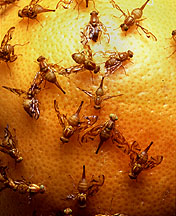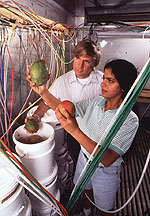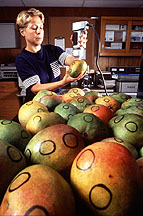Gas N' Go Grapefruit
 Mexican fruit flies laying eggs in grapefruit before a test of the reducedoxygen treatment. (K7500-1) |
How do you suffocate Mexican fruit flies that may be hitchhiking in a shipment of grapefruit--without smothering the fruit's quality before it reaches grocery stores?
A simple answer may be to take just enough oxygen out of the atmosphere in the shipping container so the flies are starved of it.
The fruits should fare well. Because they would respire or "breathe" more slowly during shipping, they would hold on longer to their fresh-picked appearance and to their flavor, sugars, moisture, and nutrients.
The principle works, but the answer is far from simple. For example, solid proof is required that air with less than 1 percent oxygen instead of the normal 20.9 percent would reliably kill all the flies. Ninety-nine percent mortality isn't good enough.
But tough federal requirements like this have not prevented progress on a new project led by Robert Mangan. An Agricultural Research Service entomologist, he heads the Crops Quality and Fruit Insects Research Unit at ARS' Subtropical Agricultural Research Laboratoryin Weslaco, Texas.
Mangan attempts to kill the bugs with a range of gas mixtures that plant physiologist Krista Shellie determines don't damage the fruit. Mangan, Shellie, and colleagues Guy Hallman and Sam Ingle began the new project this year. They aim to see if technology known as controlled atmosphere, or CA--long used commercially to maintain quality of shipped produce during 1 to 3 weeks of transport in sealed containers--could be adapted for double duty.
Weslaco's CA studies are part of a 3-year cooperative research and development agreement (CRADA) with TransFRESH Corp. of Salinas, California. "TransFRESH is the world leader in transporting fresh produce in refrigerated containers under a CA environment," says TransFRESH laboratory manager Susan Ajeska.
In 1995, the company supplied its patented CA system for shipping more than 400,000 tons of perishables from 16 terminals, including 6 in the United States. Customers are mostly exporters, importers, transportation companies, and supermarket chains. Commodities include avocados, cherries, asparagus, lettuce, melons, peaches, nectarines, plums, and other perishables.
"Ordinary refrigeration will take shipped produce a long way," Ajeska notes. But "CA can take it further, and it will arrive in better shape. If a controlled atmosphere quarantine treatment comes from the CRADA, it could help expand U.S. export markets in the Far East and Pacific Rim countries," she says.
 Biological technician Eleazar Moreno artificially infects a mango with a fruit fly larva in one of the controlled atmosphere (CA) tests. (K7500-2) |
The Weslaco researchers want CA to provide shippers with a new, in-transit insurance policy: a quarantine treatment for citrus when Mexican fruit flies infest a production area. Fruit fly invasions can trigger costly eradication programs requiring repeated aerial sprays of insecticide, and they can devastate agricultural production and trade.
The flies, native to Mexico, triggered a quarantine in part of Texas as recently as this year. Fortunately, the disruption was minor, since the outbreak was near the end of the citrus harvest. But Mexican fruit fly invasions are an annual threat in Texas and other fruit-producing states, such as California and Florida.
A Nondamaging Alternative?
Mangan, Ingle, and Shellie have developed quarantine treatments using hot water, air, or water vapor. But fruit quality sometimes suffers. Plus, the Weslaco treatments--like all other approved ones, including methyl bromide--must be done before fruit can be shipped. The CA approach could eliminate the threat of the flies without delaying shipping or damaging the fruit.
Another issue driving the Weslaco project is an environmental one: the scheduled phaseout of methyl bromide by 2001. This chemical, besides its quarantine applications for killing insects in infested fruits and vegetables, is used to protect crops from soilborne pests and diseases. It's also used to shield harvested commodities from pests during storage.
The phaseout results from an international accord signed by the United States and other countries in Montreal, Canada, in 1991. This came about because methyl bromide--along with other synthetic chemicals--contributes to depleting the ozone layer of Earth's atmosphere. The ozone layer helps protect the planet's inhabitants from excessive solar radiation.
"The Agricultural Research Service is a world leader in developing methyl bromide alternatives," Mangan says. Congress increased the agency's research funds for alternatives for methyl bromide--pre-planting and postharvest uses--from $7 million in 1993 to $13.7 million in 1996.
[Click here to see ARS' Methyl Bromide Alternatives newsletter.]
 A maze of hoses delivers precise CA gas mixtures to stored fruit. Here, entomologist Robert Mangan and TransFRESH technician Jaya Cummaragunta examine mangoes from test containers. (K7500-4) |
Mangan emphasizes that the CRADA's short-term CA goal for citrus is limited to finding an alternative to only one of methyl bromide's many uses. This goal is to see if CA can kill any and all Mexican fruit flies--adults, larvae, and eggs--infesting sealed containers of citrus for a shipping duration of 1 to 3 weeks.
Methyl bromide is the most common treatment now available for citrus. A hot-air treatment developed at Weslaco is also approved. But Mangan says it is not used yet, largely because of the cost of developing equipment at a time when the cheaper methyl bromide is still available.
Plus, Shellie notes, "uneven heating or other problems may cause loss of flavor in late-season citrus."
CA--For Better Ripening, Less Disease
For mangoes, Weslaco's search is not for an alternative to methyl bromide, known to damage the fruits. Instead, shippers want an alternative that works better than the available one, heat treatment, which accelerates ripening and can shorten shelf life.
"The controlled atmosphere treatments can result in slower, more uniform ripening. They may also delay certain postharvest diseases," Shellie says.
Weslaco's research strategy for CA includes control of temperature and humidity, as well as of oxygen, nitrogen, and carbon dioxide gases. Specific gas combinations tested are proprietary information of TransFRESH, but oxygen levels are below 1 percent. By contrast, air is about 20.9 percent oxygen, 78.1 percent nitrogen, and 0.03 percent carbon dioxide.
Outside a Weslaco laboratory sit a couple of TransFRESH's 30,000 multi-ton shipping containers. Twenty feet long, they are "the small ones," says TransFRESH lab technician Jaya Cummaragunta. "Most of our containers are twice that length." Cummaragunta works in Weslaco alongside ARS researchers.
For experiments, the containers' built-in refrigeration units keep the fruit cool. But the scientists can run several tests at a time inside them. Gas for a test comes through a tangle of thin plastic tubes that travel underground from a nearby utility building and disappear into the containers. There, the tubes deliver precise CA gas mixes under very low pressure into each of several large plastic buckets. Each bucket holds several fruits under a tight lid, with only a tiny escape hole to keep gas pressure steady.
Inside the utility building, the scientists have turned a walk-in chamber into a container surrogate. It's populated with more fruit-filled buckets and gas tubes.
All the tubes run to a "mixing board." The scientists use dials and gauges on this device to set as many as six different combinations of gas for delivery through the tubes from supply hoses on nearby tanks.
For each test, the scientists record changes in the treated fruit's skin color, firmness, and sugar and acid contents. A panel of tasters rates fruit flavor, sweetness, texture, and other qualities important to consumers.
Setting up CA tests using artificially fly-infested fruit can be a challenge, says entomologist Sam Ingle. "With grapefruit, we remove a small core of the peel, like a plug, from the stem end. Then we place several fly eggs or larvae inside the small, natural cavity beneath the peel and replace the core, sealing it with hot glue."
To infest the mangoes, the scientists need more cooperation from the flies, because taking a plug would damage the fruit's skin and flesh. So, after mangoes begin ripening, Ingle places some atop screened cages used as laboratory homes and nurseries for tens of thousands of fruit flies at a time. Upside down, adult female flies manage to deposit 20 to 30 eggs through the screen and beneath a mango's skin.
"By the end of August," Mangan says, "we'd run tests with more than 70,000 lab-reared Mexican fruit flies, about 3,500 grapefruit, and some 5,000 mangoes. Those tests examined a half-dozen different combinations of gases at five different temperatures. In some tests using artificially infested fruit, all the flies died in a matter of 1 to 3 days, without compromising the quality of the grapefruit or mangoes."
According to Shellie, "low oxygen, rather than high carbon dioxide, seems to be the key in fruit quality. We have found no damage at all to grapefruit or mangoes chilled at oxygen concentrations below 1 percent. But elevated carbon dioxide causes appearance and flavor problems."
"I'm heartened by what's happened so far," Ajeska says. "The CRADA maximizes resources of both organizations. Bob Mangan and his team design the experiments and cover the details of quarantine requirements. They frequently suggest, on the basis of a test result, what a potential treatment might look like. Then we at TransFRESH can evaluate whether it may be economically feasible. We want to do commercial tests as soon as Bob concludes from the lab trials that the time is right."
That time hasn't yet arrived, Mangan says.
"Results from some kinds of trials have been steady; other results have been tantalizing but inconsistent. So we know we have more work to do. Still, out of this may come applications for other fruits and insects, as well as Mexican fruit flies. But each insect and fruit is different."
This fall, the researchers are beginning tests with oranges, along with a second round of grapefruit studies. -- By Jim De Quattro, ARS.
Robert Mangan and Guy Hallman are in the USDA-ARS Crop Quality and Fruit Insects Research Unit, Subtropical Agricultural Research Laboratory, Weslaco TX 78596; phone (956) 447-6316.
TransFRESH Corp. is located in Salinas, CA; phone (831) 424-2911.
"Gas N' Go Grapefruit" was published in the November 1996 issue of Agricultural Research magazine.







